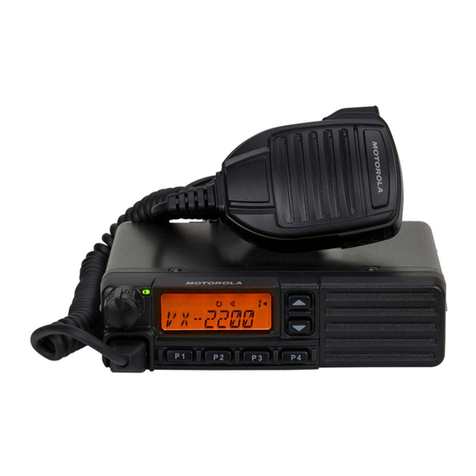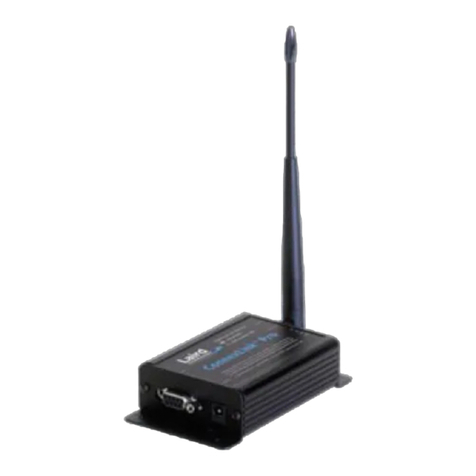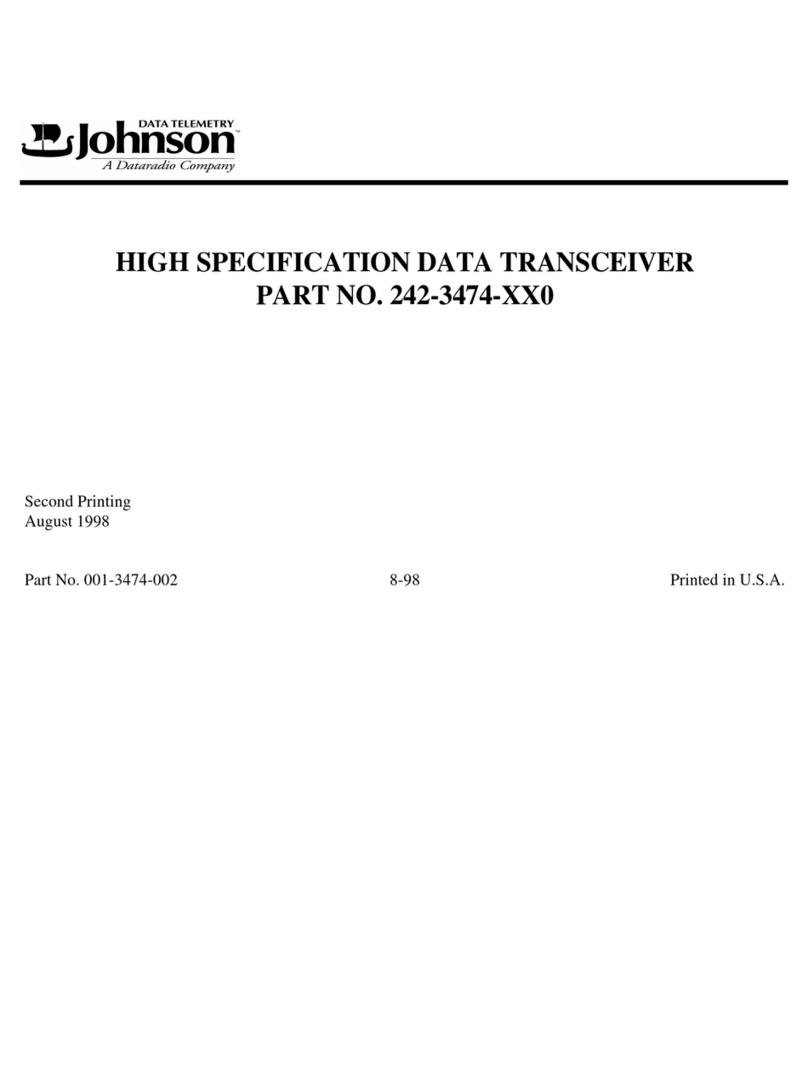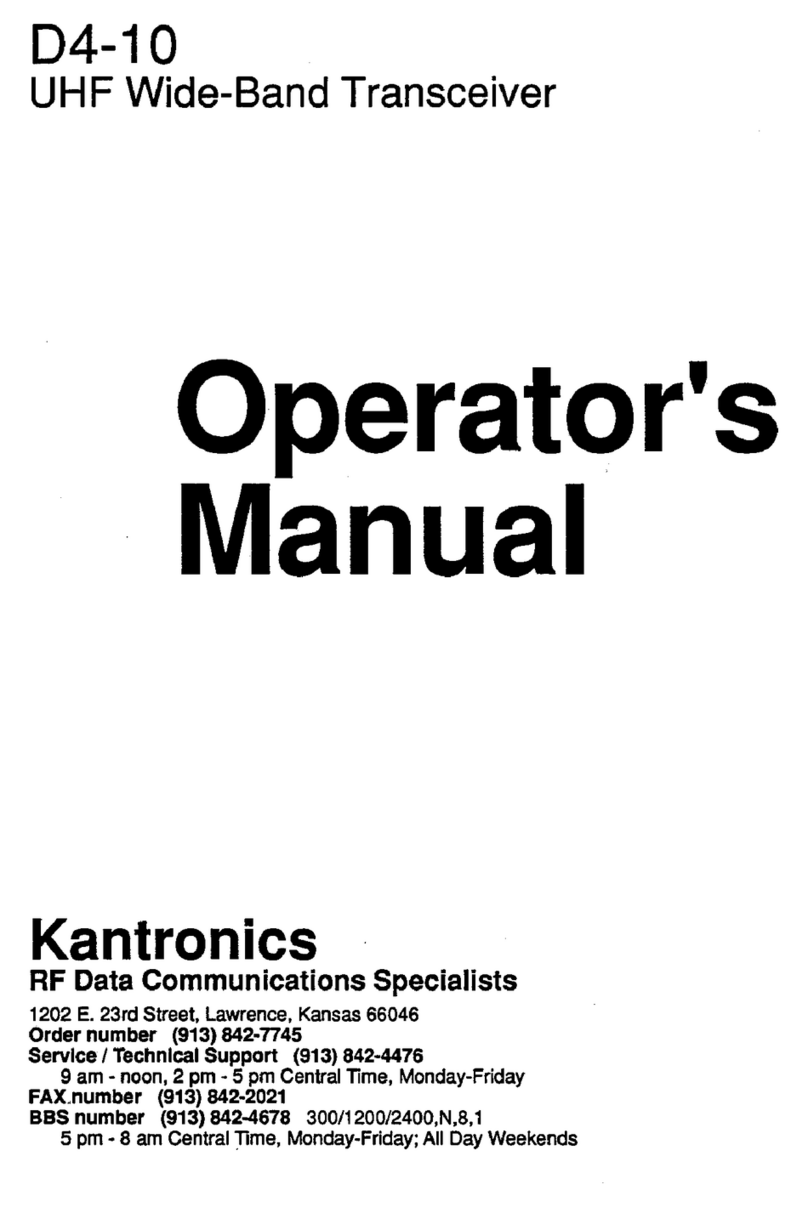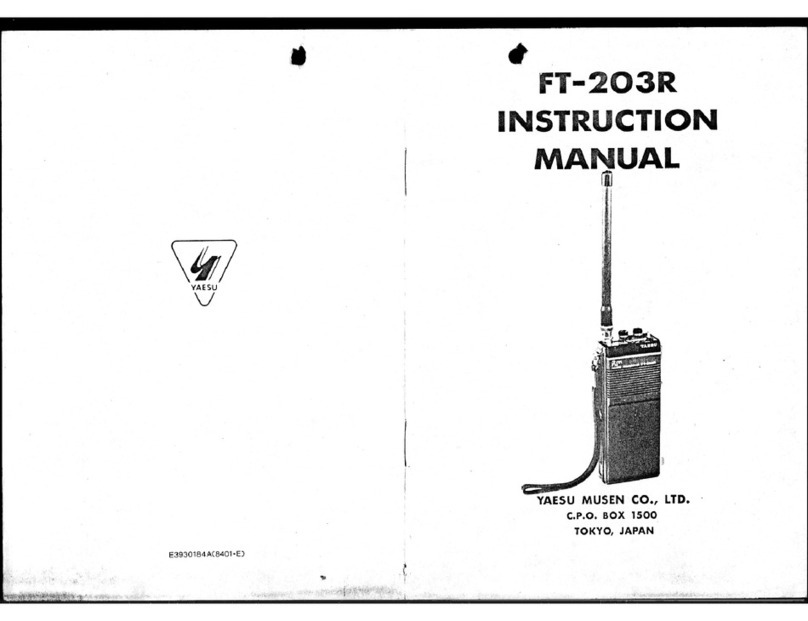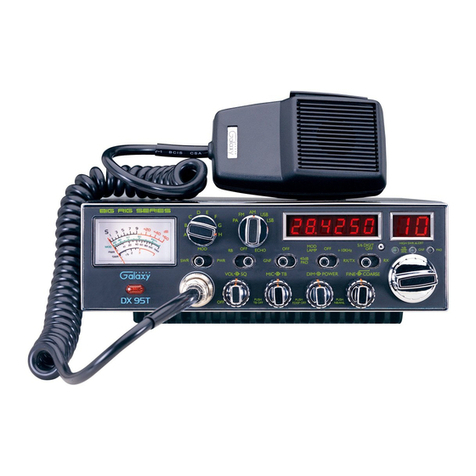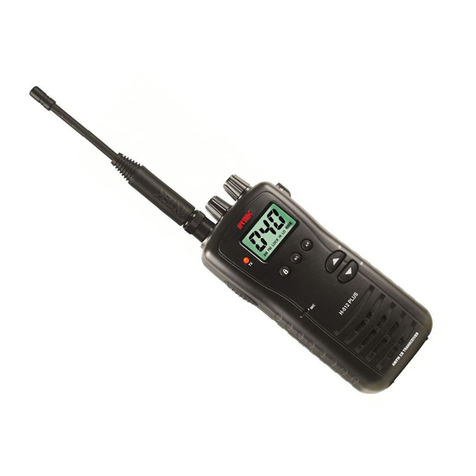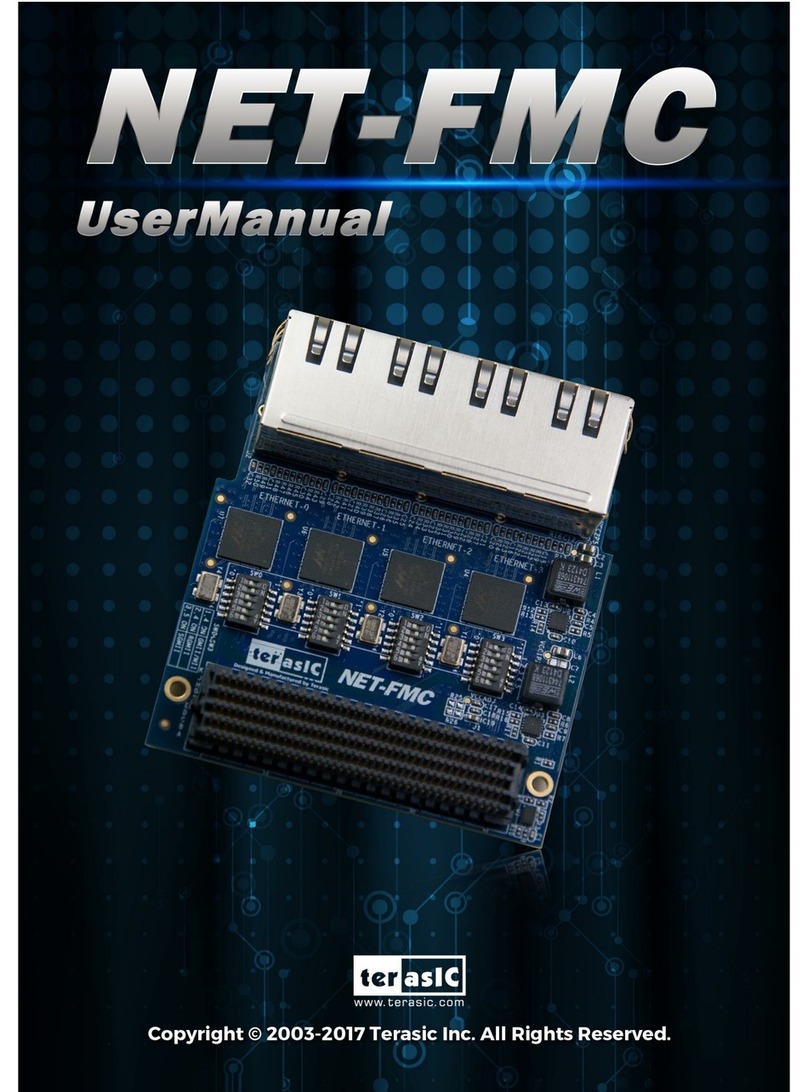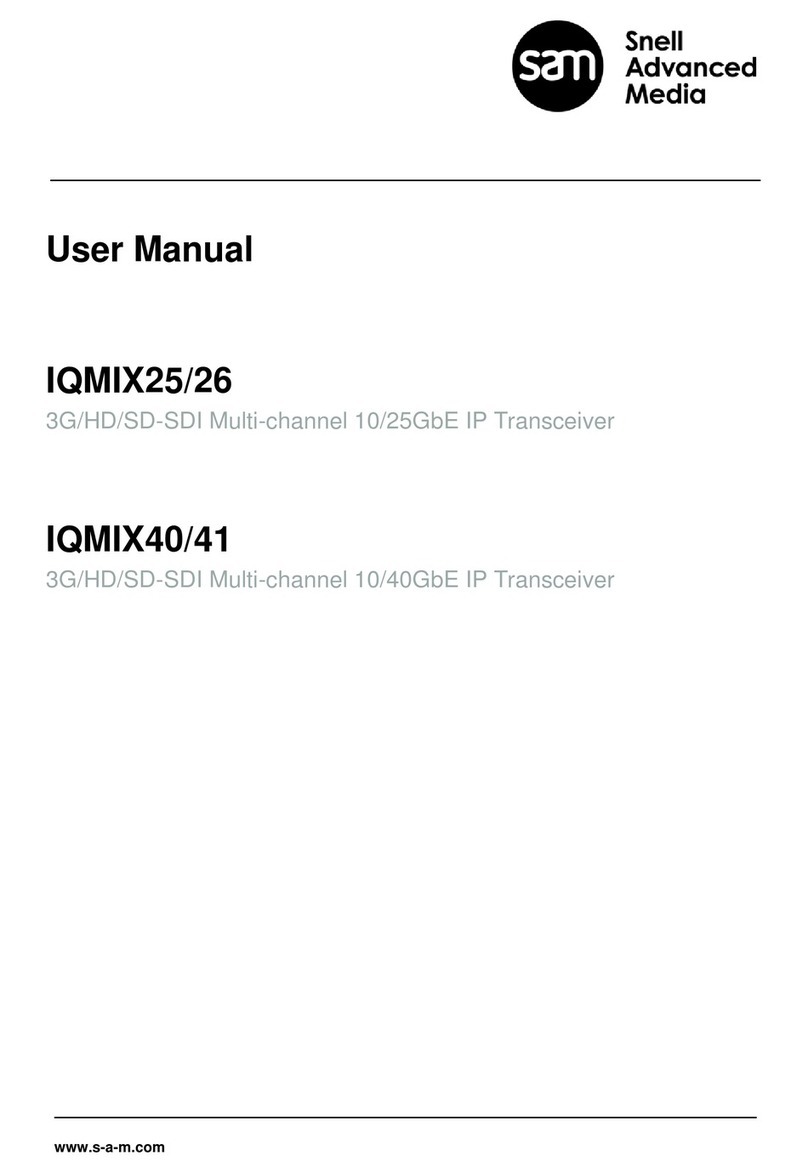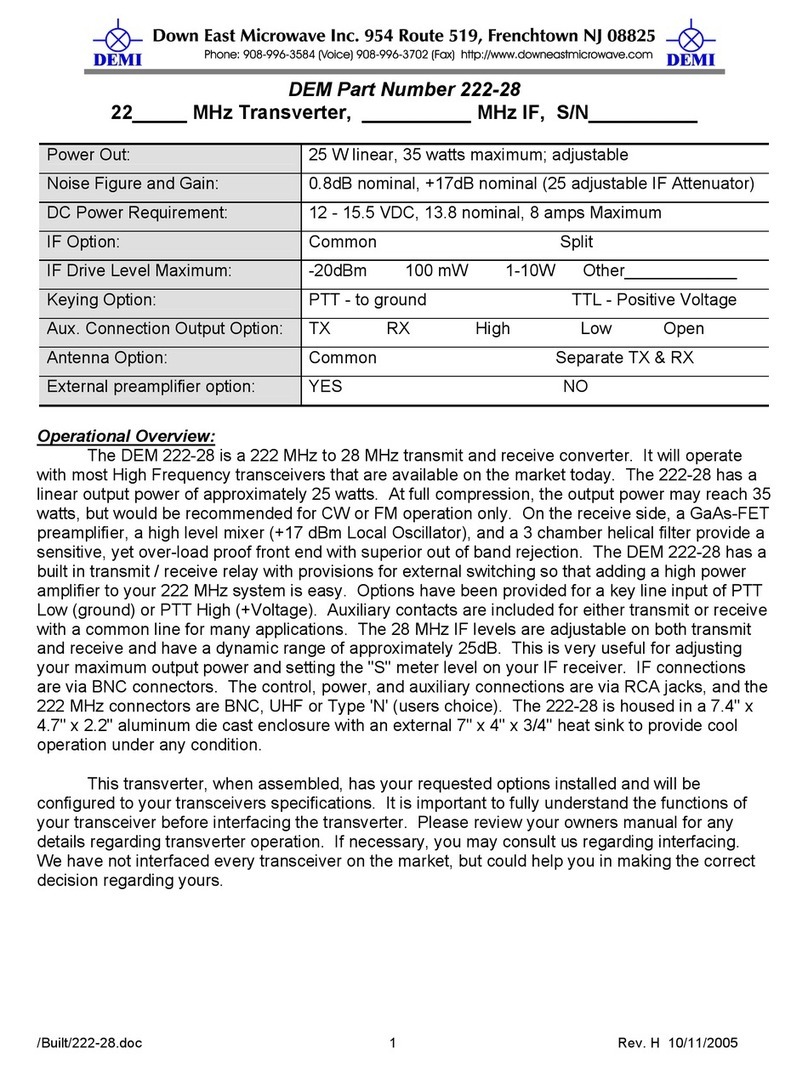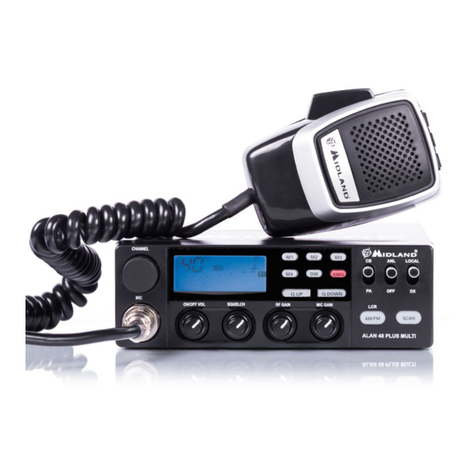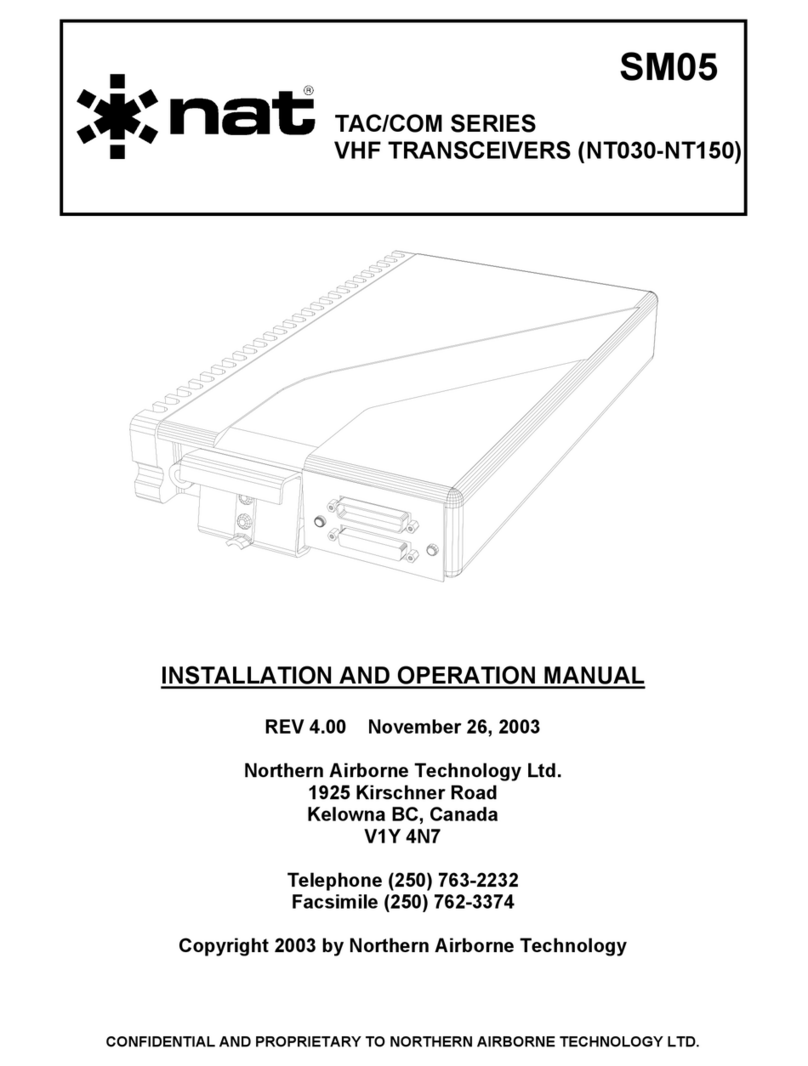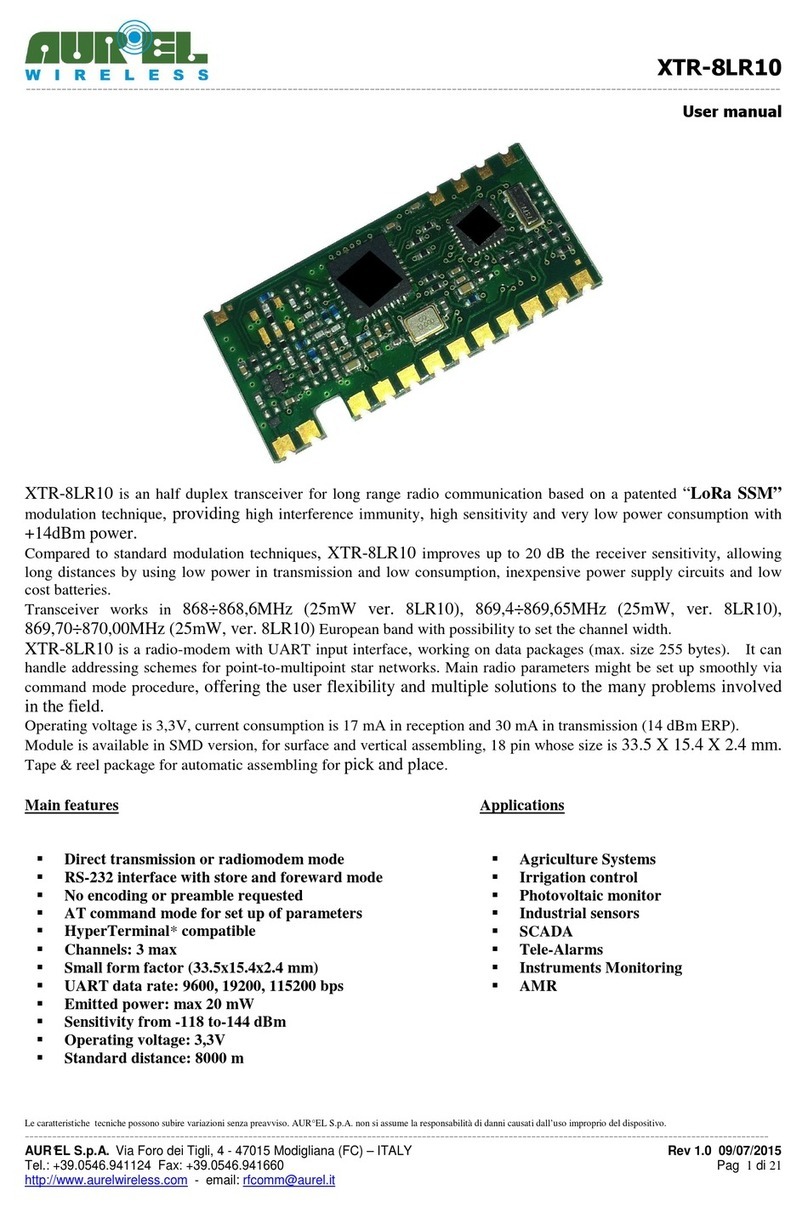Aurora VLX-TCW2H-C User manual

i
Manual Number: 181008
Firmware Rev: 3.18.0 or Higher
USERS GUIDE
VLX Series
VLX-TC1-C ● VLX-TCW2H-C ● VLX-TCW2V-C
1GbE Visual Lossless Low Latency AV over IP
Distribution
VLX-TCW2H-C
VLX-TC1-C
VLX-TCW2V-C

i
User Guide
SAFETY INSTRUCTIONS
Please review the following safety precautions. If this is the first time using this model, then read this
manual before installing or using the product. If the product is not functioning properly, please contact
your local dealer or Aurora for further instructions.
The lightning symbol in the triangle is used to alert you to the presence of dangerous voltage
inside the product that may be sufficient to constitute a risk of electric shock to anyone opening
the case. It is also used to indicate improper installation or handling of the product that could
damage the electrical system in the product or in other equipment attached to the product.
The exclamation point in the triangle is used to alert you to important operating and maintenance
instructions. Failure to follow these instructions could result in injury to you or damage to the
product.
Be careful with electricity:
⚫Power outlet: To prevent electric shock, be sure the electrical plug used on the product power cord
matches the electrical outlet used to supply power to the Aurora product. Use only the power adapter
and power connection cables designed for this unit.
⚫Power cord: Be sure the power cord is routed so that it will not be stepped on or pinched by heavy
items.
⚫Lightning: For protection from lightning or when the product is left unattended for a long period,
disconnect it from the power source.
.
Also follow these precautions:
⚫Ventilation: Do not block the ventilation slots if applicable on the product or place any heavy object
on top of it.
Blocking the air flow could cause damage. Arrange components so that air can flow freely. Ensure
that there is adequate ventilation if the product is placed in a stand or cabinet. Put the product in a
properly ventilated area, away from direct sunlight or any source of heat.
⚫Overheating: Avoid stacking the Aurora product on top of a hot component such as a power
amplifier.
⚫Risk of Fire: Do not place unit on top of any easily combustible material, such as carpet or fabric.
⚫Proper Connections: Be sure all cables and equipment are connected to the unit as described in
this manual.
⚫Object Entry: To avoid electric shock, never stick anything in the slots on the case or remove the
cover.
⚫Water Exposure: To reduce the risk of fire or electric shock, do not expose to rain or moisture.
⚫Cleaning: Do not use liquid or aerosol cleaners to clean this unit. Always unplug the power to the
device before cleaning.
⚫ESD: Handle this unit with proper ESD care. Failure to do so can result in failure.
FCC
This device complies with Part 15 of the FCC Rules. Operation is subject to the following two conditions:
(1) This device may not cause harmful interference.
(2) This device must accept any interference received, including interference that may cause undesired
operation.
Trademarks
All trademarks in this document are the properties of their respective owners.

ii
User Guide
TABLE OF CONTENTS
PACKAGE CONTENTS ................................................................................................................ 5
OPTIONAL ACCESSORIES ......................................................................................................... 6
INTRODUCTION............................................................................................................................ 9
About..................................................................................................................................................... 9
Documentation...................................................................................................................................... 9
Features.............................................................................................................................................. 10
VLX-TC1-C Front.................................................................................................................................11
VLX-TC1-C Rear................................................................................................................................. 13
VLX-TCW2H-C Front.......................................................................................................................... 14
VLX-TCW2V-C Front .......................................................................................................................... 16
VLX-TCW2H-C & VLX-TCW2V-C Rear ............................................................................................. 18
VLX-TC1-C Dante Option Slot............................................................................................................ 19
VLX-TCW2 Wall Plate Additional Button & LED Functions ................................................................ 19
UNDERSTANDING THE BASICS .............................................................................................. 20
Direct Connection with No Ethernet Switch ........................................................................................ 20
1GbE Ethernet Switch ........................................................................................................................ 20
Network Infrastructure ........................................................................................................................ 20
Isolated Network or Users Network .................................................................................................... 20
Controlling the VLX ............................................................................................................................. 21
Controlling the VLX for Redundancy .................................................................................................. 21
EDID and its Importance .................................................................................................................. 21
Videowall Capabilities ......................................................................................................................... 22
Ethernet Bandwidth Usage ................................................................................................................. 22
USB Network Bandwidth Requirement: ...........................................................................................................22
Typical Video Network Bandwidth: ..................................................................................................................23
Bandwidth Table: .............................................................................................................................................23
HARDWARE INSTALLATION..................................................................................................... 24
Network Setup .................................................................................................................................... 24
Encoder Setup .................................................................................................................................... 24
Decoder Setup .................................................................................................................................... 24
Control Setup ...................................................................................................................................... 25
Dante Option Card Setup ................................................................................................................... 25
Web Setup Pages ....................................................................................................................... 26
Encoder Mode Web Pages ................................................................................................................. 26

iii
User Guide
System Tab......................................................................................................................................................26
Network Tab.....................................................................................................................................................31
Functions Tab ..................................................................................................................................................32
Remote Tab .....................................................................................................................................................33
Management Tab.............................................................................................................................................34
Preview Tab.....................................................................................................................................................35
Decoder Mode Web Pages................................................................................................................. 36
System Tab......................................................................................................................................................36
Videowall Tab ..................................................................................................................................................41
Network Tab.....................................................................................................................................................43
Functions Tab ..................................................................................................................................................44
Remote Tab .....................................................................................................................................................45
Management Tab.............................................................................................................................................46
Preview Tab.....................................................................................................................................................47
APPLICATIONS........................................................................................................................... 48
Example 1: VLX-TCW2 Configured as Transmitter to VLX-TC1 Configured Receiver ...................... 48
Example 2: VLX Multi-Room............................................................................................................... 49
Example 3: Matrix - Multiple VLX to Multiple VLX .............................................................................. 50
Example 4: Video-Wall........................................................................................................................ 51
Example 5: KVM utilizing USB 2.0...................................................................................................... 52
SOFTWARE................................................................................................................................. 53
CONNECTOR PIN DEFINITION ................................................................................................. 55
HDMI................................................................................................................................................... 55
CAT5e/6/6A......................................................................................................................................... 55
RS-232................................................................................................................................................ 56
IR (Infrared)......................................................................................................................................... 56
APPENDIX 1 Troubleshooting.............................................................................................. 58
APPENDIX 2 Firmware Update............................................................................................. 60
APPENDIX 3 Protocol ........................................................................................................... 60
APPENDIX 4 Recommended Cabling.................................................................................. 61
APPENDIX 5 Recommended Network Switches................................................................ 62
5.1 Switch Speed ................................................................................................................................ 62
5.2 Packets Routing............................................................................................................................ 62
5.3 Ethernet Switch Configuration ...................................................................................................... 63
5.4 PoE (Power over Ethernet)........................................................................................................... 63
APPENDIX 6 Technical Specifications................................................................................ 65

5
PACKAGE CONTENTS
Please make sure the following items are included within your package. Contact your dealer if any items
are missing or damaged.
Box Versions
VLX-TC1-C
•1 qty VLX-TC1-C 1G RJ-45 Copper Tranceiver Unit
•2 qty Mounting Ears and screws
Wall Plate 2 Gang Versions
VLX-TCW2V-C
•1 qty VLX-TCW2V-C 1G RJ-45 Copper Tranceiver Unit with VGA and HDMI inputs
VLX-TCW2H-C
•1 qty VLX-TCW2H-C 1G RJ-45 Copper Tranceiver Unit with Two HDMI Inputs
Power supplies are sold separately.
Note: Go to www.auroramm.com for latest manual and firmware.

6
OPTIONAL ACCESSORIES
•VLX-TC1-RK1 (1RU Rack mount holds 2 units)
Includes 4 Rails and 1 Blank
•VLX-TC1-RK5 (5RU Rack mount holds 12 units)
Includes 24 rails and 4 Blanks
•VLX-TC1-BLK (Blank Plate for Rack Mounts) & VLX-TC1-RAIL (For VLX-TC1 use in rack
mounts)
•IPE-DTE-1 (Dante Option Card)
•VLX-LCVR (VLX Wall Plate LAN Port Cover)

7
•DXB-8 (8 Button Wall Plate)
•PS0081-1 (48V 24 Watt PoE Injector) Available in -US, -AU, - EU, and -UK worldwide models.

8
•PS0094-2 (48V 25 Watt Wall Supply) Available in -US, -AU, - EU, and -UK worldwide models.
•IR Receiver CA0026-1
•IR Emitter CA0061-1
•IR Blaster CA0049-1
•RS-232 Adaptor (3.5mm TRS to FEMALE DB9 2-TX 3-RX) CA0052-F2T3R
•RS-232 Adaptor (3.5mm TRS to FEMALE DB9 3-TX 2-RX) CA0052-F3T2R
•RS-232 Adaptor (3.5mm TRS to MALE DB9 2-TX 3-RX) CA0052-M2T3R
•RS-232 Adaptor (3.5mm TRS to MALE DB9 3-TX 2-RX) CA0052-M3T2R
•LVR-2G 2 Gang Electrical Ring

9
INTRODUCTION
About
The VLX Series provides one of the most advanced IP Streaming solutions on the
market utilizing Aurora’s IPBaseT®technology, which synergizes various IP/AV
standards to work together as one. It is the industry’s first 4K UHD transceiver with only
1.5 Frame (25ms) latency and visually losses compression. Using a transmitter (encoder)
and receiver (decoder), respectively, used to be the standard –until now. The VLX
Series box or wall plates can be set up as either one to make installation, inventory, and
troubleshooting easier.
Another industry first is the option slot to add other IP capabilities, like Dante®audio, for
a more complete, distributed system. Audio, video, data, and control can be sent
securely to one or many units using off-the-shelf 1G RJ-45 Ethernet switch. When the
VLX is set up to be a transmitter, the 2 HDMI inputs (VLX-TC1-C, VLX-TCW2H-C) or
VGA/HDMI inputs (VLX-TCW2V-2) become a source switch and the HDMI output
becomes a potential loop out. When set up as a receiver, a user can select the local
HDMI inputs or an IP source. Fast-switching of the sources further enhances the
presentation (Matching source resolutions and frame-rate required). Regardless of how
the VLX is set up, the audio can be de-embedded at any location, and/or be sent to or
received from a Dante® enabled device. The USB is also flexible, working as a KVM
and/or a high-speed data transfer (50Mbps) for memory sticks. Each VLX USB feature
can also be set as a host or a device. To keep the system friendly, an OSD and
integrated web server are available for easy navigation and setup of features.
Digital signage, education, corporate, and residential are just a few markets which
benefit from the flexibility and low cost of the VLX Series.
Documentation
Aurora provides many documents to support the VLX series and accessories. Below is a list of the
available documents that can be found on the download tab of the VLX products or the customer portal.
•VLX Series Network Switch Recommendation & Configuration
•VLX Series Protocol Guide (Available only on Customer Portal)
•IPBaseT®FAQ (Frequently Asked Questions)
•IPBaseT®VLX Series AV Evolution for an Industry Revolution (Features and the benefits over
tradition Matrix)
•IPBaseT®Brochure
•IPBaseT®for Better Education

10
Features
◆Configure as Transmitter (Encoder) or Receiver (Decoder)
◆4K60 4:2:0/4K30 4:4:4 Over 1G CAT5e/6/6a
◆HDMI 2.0, HDCP 2.2
◆Visually Lossless with only 1.5 Frame Latency
◆1080P to 4K and 4K to 1080P Scaling
◆128 per source with HDCP, Larger for Non-Encrypted Sources
◆Videowall with Image Rotation
◆1G LAN PoE
◆2 HDMI Inputs, 1 HDMI Output (VLX-TC1-C, VLX-TCW2H-C)
◆1 VGA/1 HDMI Inputs, 1 HDMI Output (VLX-TCW2V-C)
◆Line In/Out Stereo
◆RS-232 Serial Port & IR (In/Out)
◆On Screen Display (OSD)
◆Integrated Web Server for Configuration and control
◆USB 2.0 Host and Device ports
◆Two USB 1.1 for HID devices (VLX-TC1-C)
◆Dante®IP Audio Option
◆Front Keypad & IR Remote with lockout function
◆Auto Sense Switching
◆Rack & Under Table Mounting (VLX-TC1-C)
◆2 Gang Mounting for Wall plates (VLX-TCW2V-C, VLX-TCW2H-C)
◆Available in White or Black (VLX-TCW2V-C, VLX-TCW2H-C)
* Wall plate versions require full 2 gang electrical box space. Some electrical boxes and
mud rings do not accommodate the full size. Read specifications for dimensions.

11
VLX-TC1-C Front
LEDs
•Power/Status – Power will light green when unit is on or in standby. Status will blink at a
normal pace during regular operation and slower pace when in standby.
•Encoder/Decoder – Encoder (transmit) or Decoder (receiver) will be lit when set
accordingly.
•HDMI 1/HDMI 2 – Will light accordingly based on input selection. If both are lit, then it is
the remote stream when set as a decoder. If neither is lit, then no source is routed.
•232 TX/RX – Will blink when RS-232 data is being sent or received.
•IR TX/RX – Will blink when IR signal is being sent or received
•Host/Device – For USB option. Host will be lit if set for PC to be connected to the USB.
Device will be lit if set for peripherals like keyboard or mouse is to be connected.
•LAN connector LED’s (Rear):
oLeft LED Green = 1G/Good.
oLeft LED Orange = 10/100 or Bad Connection.
oRight LED is Orange, for general LAN activity.
Buttons
•Power Button – Press and hold for 5 seconds for power standby.
•Menu Button – Press and hold for 5 seconds to switch between encode/decode mode.
•Up Button - Select next input source.
•Down Button - Select previous input source.
•Enter Button – Pressing will toggle Link On/Off. This stops streamed Video, IRoIP, SoIP
and USBoIP. If the VLX device is connected in the network the status led will go on/off to
indicate that link has gone on/off.
Miscellaneous
•IR Window – Future use for IR remote and IR Pass through.
•IR Input – For use with external IR Receiver. If utilized, front IR window will become
disabled. Note: It is important to use 5V only IR photo receiver which is with carrier and
inverted. Use a stereo 3.5mm TRS connector.
•USB HID – Dual Type A USB 1.1 Connectors for keyboard/mouse

12
Special Functions
•Factory Default - Press Power and Menu for 5 seconds. The USB Host LED will blink to
indicate factory default and the unit will reboot.
•Reboot - Press Power button for 5 seconds. Power LED go off and the board reboots.
•Secondary Firmware Image Mode - Press Power and Down button while powering up
for 5 seconds. The Host and Device LEDs will keep blinking and both Encoder and
Decoder LEDs will be on.
•IP Information on RS-232 – Press and hold Up and Down for 5 seconds and the units IP
information will reveal on RS-232 port at 9600 baud 8N1.
Note: Default Settings - 9600 baud rate; default IP DHCP 169.xxx.xxx.xxx range; autosense off.

13
VLX-TC1-C Rear
Rear
From left to right
48VDC
48 Volt DC isolated power input.
LAN
10/100/1000Mbps LAN.
Can power the unit with PoE from injector or switch.
LAN connector LED’s (Rear):
•Left LED Green = 1G/Good. (1G Req’d for proper operation)
•Left LED Orange = 10/100 or Bad Connection.
•Right LED is Orange, for general LAN activity.
USB 2.0
50Mbps USB 2.0 Type A to be connected to a host (PC) or Type B for
device (ex. Mouse, keyboard, etc.).
HDMI In 1/ In 2
HDMI inputs up to 4K30p/4:4:4 or 4K60p/4:2:0.
HDMI Out
HDMI Output to Display up to 4K30p/4:4:4 or 4K60p/4:2:0.
Output can be native or scaled (e.g. from 1080p to 4K30p/4:4:4)
Audio In
Analog stereo audio input.
Audio Out
Analog stereo audio output.
De-embedded audio output from HDMI stream. HDMI multichannel audio
(up to 7.1) is downmixed to stereo (2 channel).
Control RS-232
Serial port pass-through and control up to 115Kbps.
Control IR Out
Infrared control output 30kHz-60kHz.
IR emitter must be mono 3.5mm TS.
Commented [A1]: We should state if scalling is possible
Commented [A2]: The audio is downmixed from
multichannel to stereo? We should state at this point the
functionality.

14
VLX-TCW2H-C Front
Buttons
•In 1 – Selects HDMI Input 1 (Lights Red, Green, or Blue).
•In 2 – Selects HDMI Input 2 (Lights Red, Green, or Blue).
•Stream – Selects remote stream assigned when set as decoder (Lights Red, Green, or
Blue). If held for 5 sec will switch between encode and decode modes. Stream button will
light blue when in encode mode.
Connectors
•HDMI In 1/2 – HDMI inputs up to 4K30 4:4:4/4K60 4:2:0.
•HDMI Out – HDMI Output to Display.
•RS-232 – Serial port pass-through and control up to 115Kbps.
•IR Output – For InfraRed output of 30kHz-60kHz. Uses 3.5mm TS emitter.
•Audio In – Stereo audio input.
•Audio Out – Audio de-embedded output.
•Ethernet – 10/100 LAN.
•USB – USB 2.0 Type A to be connected to a host (PC) or device (ex. Mouse, keyboard,
etc.).
Miscellaneous
•IR Window – Future use for IR remote or IR pass-through.

15
Special Functions
•Factory Default - Press In1 and In2 button till white LED turns on for a second. Release
the switches once the white led turns on, on both the buttons. The unit will reboot
automatically after factory default.
•Reboot - Press In1 button for 5 seconds. All lit LEDs will be off now and the board
reboots.
•Secondary Firmware Image Mode - Press In1 and In2 button while powering up for 5
seconds. The LED in buttons In1 and In2 will light Red once the board has finished
booting to indicate secondary mode. This may be necessary if for some reason the
firmware becomes corrupted during a firmware update.
LED Indications
•When power is first applied, all front LEDs will light white for a second.
•All LEDs will light white to indicate that the firmware update is in progress.
•Selected input source LED will light red.
•Encoder mode is indicated by a blue led on stream button.
•Both In1 and In2 LEDs will light Red to indicate secondary mode.
Note: Default Settings - 9600 baud rate; default IP DHCP 169.xxx.xxx.xxx range; autosense off.

16
VLX-TCW2V-C Front
Buttons
•In 1 – Selects VGA (Lights Red, Green, or Blue).
•In 2 – Selects HDMI Input 2 (Lights Red, Green, or Blue).
•Stream – Selects remote stream assigned when set as decoder (Lights Red, Green, or
Blue). If held for 5 sec will switch between encode and decode modes. Stream button will
light blue when in encode mode.
Connectors
•VGA In – VGA input up to 1900 x 1200 @ 60Hz
•HDMI In – HDMI inputs up to 4K30/4:4:4 or 4K60/4:2:0.
•HDMI Out – HDMI Output to Display.
•RS-232 – Serial port pass-through and control up to 115Kbps.
•IR Output – For InfraRed output of 30kHz-60kHz. Uses 3.5mm TS emitter.
•Audio In – Stereo audio input.
•Audio Out – Audio de-embedded output.
•Ethernet – 10/100 LAN.
•USB – USB 2.0 Type A to be connected to a host (PC) or device (ex. Mouse, keyboard,
etc.).
Miscellaneous
•IR Window – Future use for IR remote or IR pass-through.

17
Special Functions
•Factory Default - Press In1 and In2 button till white LED turns on for a second. Release
the switches once the white led turns on, on both the buttons. The unit will reboot
automatically after factory default.
•Reboot - Press In1 button for 5 seconds. All lit LEDs will be off now and the board
reboots.
•Secondary Firmware Image Mode - Press In1 and In2 button while powering up for 5
seconds. The LED in buttons In1 and In2 will light Red once the board has finished
booting to indicate secondary mode. This may be necessary if for some reason the
firmware becomes corrupted during a firmware update.
LED Indications
•When power is first applied, all front LEDs will light white for a second.
•All LEDs will light white to indicate that the firmware update is in progress.
•Selected input source LED will light red.
•Encoder mode is indicated by a blue led on stream button.
•Both In1 and In2 LEDs will light Red to indicate secondary mode.
VGA Port Resolutions
•800x600
•1024x768
•1280x720
•1280x768
•1280x800
•1280x960
•1280x1024
•1360x768
•1440x900
•1600x1200
•1680x1050
•1920x1080
Note: Default Settings - 9600 baud rate; default IP DHCP 169.xxx.xxx.xxx range; autosense off.

18
VLX-TCW2H-C & VLX-TCW2V-C Rear
Rear
•48VDC – 48 Volt DC isolated power input.
•LAN – 10/100/1000Mbps LAN. Can power the unit with PoE from injector or switch.
•RS-232 – Serial port pass-through and control up to 115Kbps. Also, has 5V for
connection to DXB-8 8 button wall controller.
•Expansion Slot for Dante option. Cover supplied for card protection.
Wall plate versions require full 2 gang electrical box space. Some electrical boxes and
mud rings do not accommodate the full size. VLX-TCW2 wall box dimensions are 3.728”
x 2.83” x 1.404”. Wall box portion depth is 1.404” without option card and 2.25" with
option card.

19
VLX-TC1-C Dante Option Slot
•Option Card Slot for Dante option.
Note: The MAC address for the Dante option will be on the card label.
VLX-TCW2 Wall Plate Additional Button & LED Functions
LED Indications
•Encoder/Decoder Indication - Blue LED to be lit on Stream button in Encoder Mode.
•Source Indication - Red LED to be lit on the button corresponding to the source.
Button Functionalities
•Secondary boot - Press and hold the IN2 button while booting.
•Factory default - Press and hold the IN2 and Stream button for 5 seconds.
•Encoder Decoder Selection - Press and Hold Stream button for 5 seconds
•Reboot - Press and Hold IN1 button for 5 seconds.
This manual suits for next models
7
Table of contents
Other Aurora Transceiver manuals
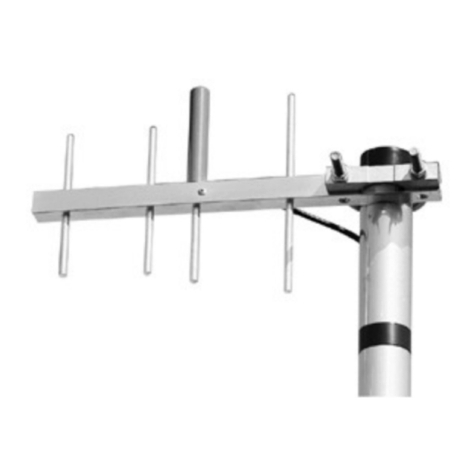
Aurora
Aurora MLink Ultra User manual
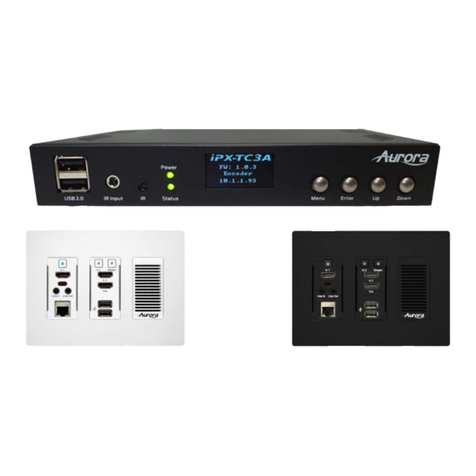
Aurora
Aurora IPX-TC3A Series User manual

Aurora
Aurora IPX series User manual
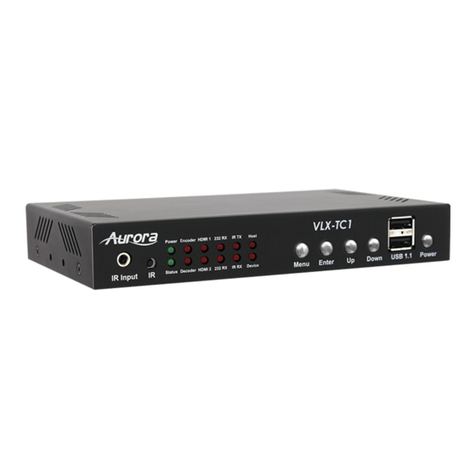
Aurora
Aurora VLX-TC1-CF User manual
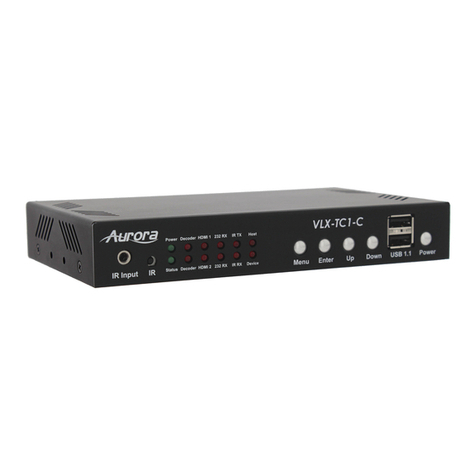
Aurora
Aurora VLX-TC1-C User manual
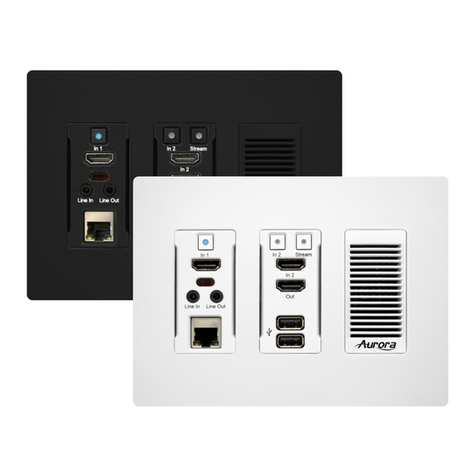
Aurora
Aurora IPX-TC3 Series User manual
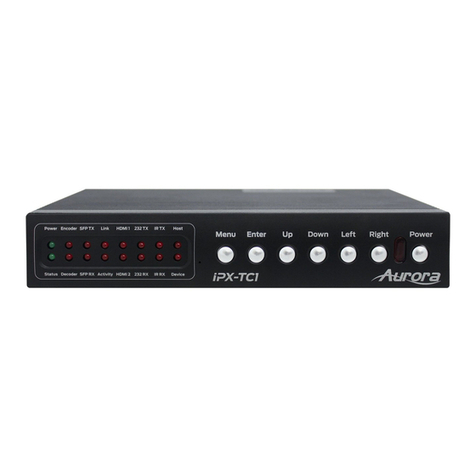
Aurora
Aurora IPX-TC1-F User manual

Aurora
Aurora VLX-TC1-C User manual
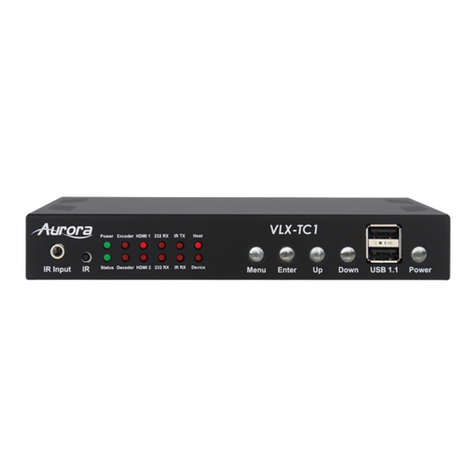
Aurora
Aurora IVLX-TCW2V-C User manual

